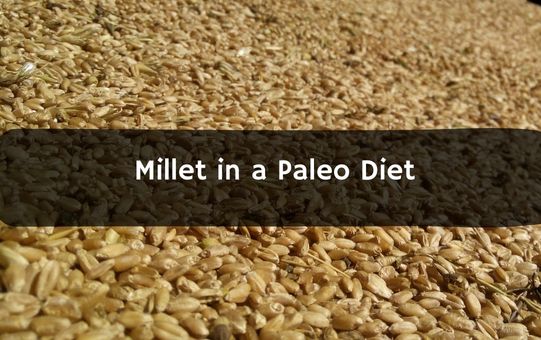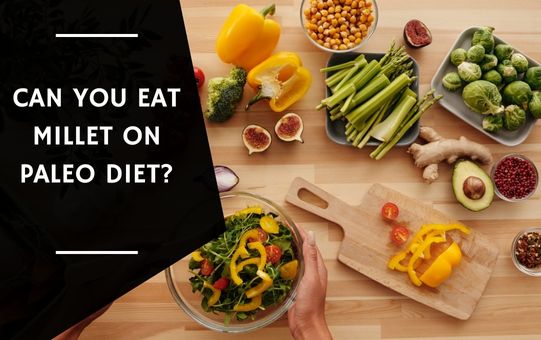Are you wondering if millet is allowed on the Paleo diet? Can you eat millet on Paleo Diet? This ancient grain has a long history of use as a staple food in numerous cultures, and it is an excellent source of fiber, protein, and numerous minerals.
According to the strict guidelines of the Paleo Diet, millet is not a “Paleo” food because it is a grain, and grains are prohibited on the diet. However, some Paleo Diet adherents may choose to include millet as an occasional treat in their diet.
Consider the pros and cons of including millet in a Paleo Diet, as well as the limited research on the health effects of millet consumption on this diet. Other “Paleo-friendly” grains, such as wild rice, quinoa, and buckwheat, may be more appropriate for regular Paleo Diet consumption.
In this article, we’ll discuss the benefits and drawbacks of including millet in the Paleo Diet, as well as other grains that may be more suitable for regular consumption on this popular eating plan.
Contents
Why Eat Millet on a paleo Diet matter?
The question of whether or not to include millet in a Paleo Diet may be of interest to some people because millet is a good source of nutrients and is naturally gluten-free. However, it is important to consider the fact that millet is a grain, and grains are not allowed on the strict guidelines of the Paleo Diet.
The theory behind this is that grains were not a significant part of the diet of our Paleolithic ancestors, and they are thought to be less nutritious and more difficult to digest than other types of foods.
Therefore, including millet in a Paleo Diet may not align with the goals of the diet, such as improved digestion and reduced inflammation. It is also worth noting that there is limited research on the health effects of consuming millet on a Paleo Diet.
Read Also: Can You Eat Millet on a Low-Carb Diet?
History of the Paleo Diet
The Paleo Diet, also known as the “Caveman Diet,” is a popular eating plan that aims to emulate the diet of our hunter-gatherer ancestors. It is based on the idea that our bodies are better suited to the types of foods that were available during the Paleolithic era (roughly 2.5 million to 10,000 years ago), before the widespread adoption of agriculture.
The theory behind the Paleo Diet is that our bodies have not evolved to properly digest the foods that have become common in the modern diet, such as grains, legumes, and dairy products. As a result, proponents of the Paleo Diet argue that these foods can lead to a variety of health problems, including obesity, diabetes, and autoimmune disorders.
Instead, the Paleo Diet focuses on whole, unprocessed foods, including meats, seafood, vegetables, fruits, nuts, and seeds. These foods are believed to be more nutritious and easier for the body to digest, and they are thought to be more closely aligned with the types of foods that our ancestors ate.

What is Millet and is it Considered a “Paleo” Food?
Millet is a type of grain that is commonly grown in Asia and Africa, and it has a long history of use as a staple food in many cultures. It is a small, round grain that is similar in appearance to quinoa or couscous, and it has a slightly sweet, nutty flavor.
Millet is a good source of nutrients, including fiber, protein, and a variety of minerals. It is also naturally gluten-free, which makes it a popular choice for people with gluten sensitivities or celiac disease.
However, millet is not considered a “Paleo” food, according to the strict guidelines of the diet. This is because it is a grain, and grains are not allowed on the Paleo Diet. The theory behind this is that grains were not a significant part of the diet of our Paleolithic ancestors, and they are thought to be less nutritious and more difficult to digest than other types of foods.
The Pros and Cons of Including Millet in a Paleo Diet
Despite the fact that millet is not considered a “Paleo” food, some people may still be interested in incorporating it into their diet, either as an occasional treat or as a regular part of their meals. Here are some pros and cons to consider if you’re thinking about including millet in a Paleo Diet:
Pros:
- Millet is a good source of nutrients. As mentioned earlier, millet is a good source of fiber, protein, and a variety of minerals. It is also naturally gluten-free, which can be beneficial for people with gluten sensitivities or celiac disease.
- Millet is versatile and easy to prepare. Millet can be cooked and eaten in a variety of ways, including as a side dish, in soups and stews, or as a breakfast porridge. It is also easy to cook, requiring only about 20-30 minutes of boiling time.
Cons:
- Millet is a grain, and grains are not allowed on the Paleo Diet. While some people may choose to include millet in their diet as an occasional treat, it is not considered to be in line with the principles of the Paleo Diet.
- There is limited research on the health effects of millet on the Paleo Diet. While there is some research suggesting that millet can be a nutritious addition to the diet, there is limited research specifically looking at the health effects of consuming millet on a Paleo Diet. It is possible that consuming millet on a regular basis may not align with the goals of the diet, such as improved digestion and reduced inflammation.
Other Grains that are Allowed on a Paleo Diet
Whole grains are generally not allowed on the Paleo Diet, there are a few exceptions. Some people who follow a Paleo Diet may choose to include certain types of grains in their diet as an occasional treat, as long as they are properly prepared.
The following grains may be included in a Paleo Diet in moderation:
- Wild rice: Wild rice is a type of grass that is native to North America, and it is considered to be more nutrient-dense and easier to digest than other types of rice.
- Quinoa: Quinoa is a grain-like seed that is native to South America, and it is a good source of protein, fiber, and a variety of minerals. It is also naturally gluten-free.
- Buckwheat: Buckwheat is a type of seed that is related to rhubarb, and it is a good source of protein, fiber, and a variety of minerals. It is also naturally gluten-free.
It’s important to note that even these “Paleo-friendly” grains should be consumed in moderation and not as a regular part of the diet.
Read Also: Does Millet Cause Heat?
Conclusion
Millet is not considered a “Paleo” food according to the strict guidelines of the diet. However, some people who follow a Paleo Diet may choose to include it in their diet as an occasional treat. While millet is a good source of nutrients and is naturally gluten-free, it is a grain and may not align with the goals of the diet, such as improved digestion and reduced inflammation.
If you’re interested in including millet in your diet, it’s important to do so in moderation and to consider the pros and cons discussed above. Other “Paleo-friendly” grains, such as wild rice, quinoa, and buckwheat, may be more suitable options for regular inclusion in a Paleo Diet.
FAQs | Eat Millet on Paleo Diet
Here are 5 relevant FAQs for the topic of “Can You Eat Millet on a Paleo Diet?”:
Is Millet Allowed On The Paleo Diet?
Millet is not considered a “Paleo” food according to the strict guidelines of the diet. This is because it is a grain, and grains are not allowed on the Paleo Diet.
Some people who follow a Paleo Diet may choose to include millet in their diet as an occasional treat, but it is not considered to be in line with the principles of the diet.
Is Millet A Good Source Of Nutrients?
Yes, millet is a good source of nutrients. It is a good source of fiber, protein, and a variety of minerals, and it is also naturally gluten-free.
However, it is important to note that millet is a grain, and grains are generally not considered to be as nutrient-dense or easy to digest as other types of foods.
can you eat rice on paleo?
Rice is generally not considered a paleo food as it is a grain. The paleo diet typically excludes grains and focuses on whole, unprocessed foods that were available to humans during the Paleolithic era. However, some people who follow a less strict version of the paleo diet may include rice in their diet.
Can Millet Be Included In A Grain-Free Diet?
Millet is a grain, so it is not suitable for a grain-free diet. If you are following a grain-free diet, it is important to avoid all grains, including millet.
is millet paleo?
Millet is not considered a strict paleo food as it is a grain. The paleo diet typically excludes grains and focuses on whole, unprocessed foods that were available to humans during the Paleolithic era. However, some people who follow a less strict version of the paleo diet may include millet in their diet.

